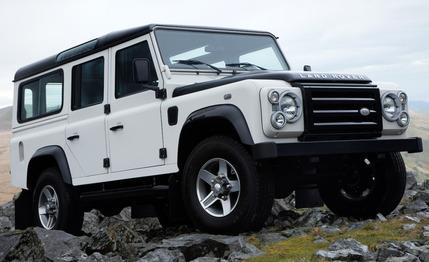
 First Drive Review
First Drive Review
The Gillies household rarely disagrees about vehicles. I will tend to talk more about the finer details of the handling, brakes, and power delivery than Jane and the twins, but we can usually agree whether a car is good, bad, or indifferent. The only exceptions are that Emma likes everything that has a Mercedes-Benz badge on it, and Cameron thinks the Bugatti Veyron is the greatest car in the world, because the BBC’s Top Gear team says it is and won’t listen to Dad’s protestations about its being an overpriced, overengineered travesty. But then he’s never driven a McLaren F1, so he doesn’t really know.
Thinking Inside the Box
However, when it came to the Land Rover Defender 110 station wagon, all three of them hated it. They didn’t like the way it looked or drove and just couldn’t get their heads around it. But I adored it. It looks great, for one. The boxy aluminum bodywork is remarkably similar to that of the 1948 original, with a muscularity and purity of purpose that is utterly charming. The optional checker-plate protection on the fenders and rockers looks a bit affected, though.
Inside, the seats, the dashboard, the heating and ventilation system, the stereo, and the instruments were revised in an extensive overhaul carried out in 2007 but remain remarkably simple and very user-friendly. The driving position is more commanding than anything this side of a Peterbilt’s, although we’d have preferred a steering column that’s adjustable, as well as more oddment space. Despite the 110-inch wheelbase and 183-inch overall length, second-row legroom is merely adequate, and the two fold-down chairs that constitute the third row impinge on cargo space.
Of course, Jane and the kids were right that the Landie isn’t great on-road. The thing has the turning circle of a supertanker, and the steering is slow to react to inputs. The company claims the 121-hp, 2.4-liter turbo-diesel four-cylinder gets this 4200-pound vehicle from 0 to 60 mph in fewer than 15 seconds, acceleration that’s as leisurely as the service in a bad restaurant. Overtaking is an adventure, thanks to the lack of power, even if the 258 lb-ft of torque are available from as low as 2000 rpm. One advantage of this lack of performance: You’re unlikely to get too many tickets when the top speed is 82 mph.
Around corners, the Defender rolls like a barrel on a river. Handling? Well, the front tires squeal a lot. Above 70 mph, the bricklike styling is responsible for loads of wind noise. This vehicle isn’t a bargain, either, at about $48,000, adjusted for currency and shorn of the U.K.’s value-added tax. For that money, you get roll-up rear windows and side mirrors that have to be adjusted manually, from the outside. One bright spot: I reckoned that 22 mpg overall was pretty good for such a boxy, heavy SUV.
A Different Approach Is a Welcome Departure
But the Defender’s dated on-road manners have an unexpected benefit in that they force one to drive differently, anticipating corners early and planning overtaking maneuvers well in advance. On roads where most modern cars are running 80 mph, the Landie is hard at work turning 60 mph. It makes you slow down, sustain momentum, and take in the views, rather than rushing around like an idiot. On Britain’s overcrowded roads, where the populace has been cowed into driving 15 mph under the speed limits by the ubiquity of speed cameras and a nanny-state judiciary that punishes speeding motorists more harshly than burglars, such an approach is quite soothing.
And one has to remember that all vehicles are a compromise. You’re not going to take a Ferrari F430 off-road or tow a big trailer with a Honda Accord, after all. Landies are very good at going off-road and towing. In 2001, I used one to take a vintage car and a heavy trailer down to Monaco from the U.K., and we barely noticed there was anything behind us. A Defender 110 will tow up to 7716 pounds of braked trailer and haul it very comfortably.
From previous experience, Defenders are awesome off-road, although the nearest we came to the rough stuff on this trip was the farm track to my dad’s workshop. Land Rover quotes a 45-degree maximum gradient; 49- and 35-degree approach and departure angles, respectively; 20 inches of wading depth; and a minimum ground clearance of 12 inches. The permanent all-wheel-drive system has a two-speed transfer case, and anti-lock brakes and traction control were standard on our uplevel XS model. If you can’t get there in a Defender, you’re probably in need of a tracked vehicle. Or a boat.
The Defender enjoyed a brief U.S. sales stint in the ‘90s that came to an end as a result of increased safety regulations. One hopes Land Rover will engineer the next-generation Defender with the U.S. in mind, because it’s a supremely capable vehicle that would have an enthusiastic, if select, audience here. Like the Jeep Wrangler, it’s one of the few truly authentic off-roaders remaining, now that vehicles like the Range Rover and Toyota Land Cruiser have become styling rides for the school run.